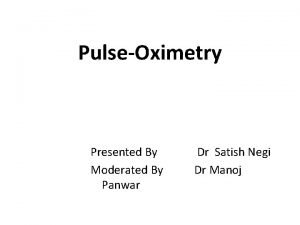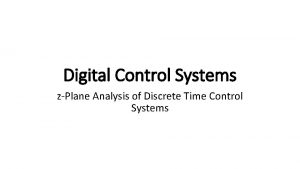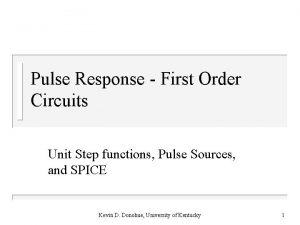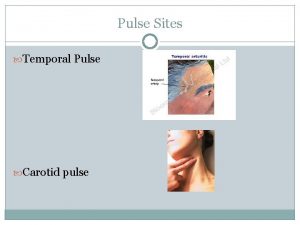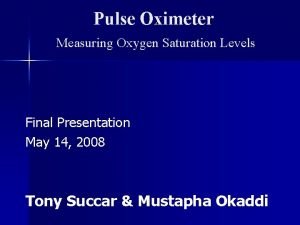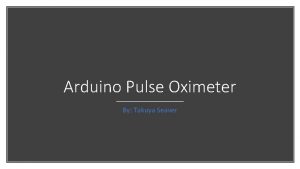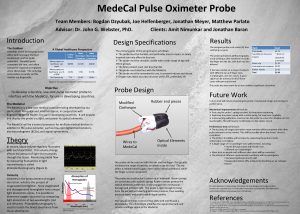Pulse Oximeter o principles of operation function use










- Slides: 10

Pulse Oximeter o principles of operation function use scientific principles o construction components system diagram inputs/outputs o troubleshooting identifying common faults replacing components rectifying faults o safety considerations user and patient safety 13. 3. 3 Maintain a pulse oximeter. Unit B 13. 3 Maintaining General Bedside Nursing Equipment Module 279 18 B Medical Instrumentation I © dr. Chris R. Mol, BME, NORTEC, 2015

Function: measure oxygen saturation of the blood What is oximetry ? Oximetry is a non-invasive method of measuring the oxygen saturation of the (hemoglobin in the) blood. This is a good indicator of the oxygen carrying capacity of the blood. A blood-oxygen monitor displays the percentage of blood that is loaded with oxygen. More specifically, it measures what percentage of hemoglobin, the protein in blood that carries oxygen, is loaded. Why is it important ? All tissues in the body depend on oxygen for survival. A shortage of oxygen in the tissues is called hypoxia. When a patient is hypoxic their tissues lose the bright red appearance of being well oxygenated and become dark red. The brain is damaged very quickly if the supply of oxygen to the tissues is interrupted. What are normal values for the blood oxygen content ? What if a patient has an abnormal blood oxygen content ? © In a healthy human, nearly 100% of the hemoglobin is saturated all of the time in the arteries. Acceptable normal ranges for patients without pulmonary pathology are from 95 to 99 percent. The causes of hypoxemia can be sleep apnea, asthma crisis, pulmonary infection, etc. Possible actions include giving more (supplemental) oxygen, …. dr. Chris R. Mol, BME, NORTEC, 2015 Maintain a pulse oximeter

Use: many places in the hospital and at home The probe can be placed on a finger, ear lobe, toe or forehead depending upon its design. Some probes are single use while others are multi-use. Multiuse probes are preferred in the developing world. However, disposable probes are often reused. The Pulse (Heart) Rate is 72 beats per minute The oxygen saturation is 98% Pulse oximetry is very convenient for non-invasive continuous measurement of blood oxygen saturation. In contrast, blood gas levels must otherwise be determined in a laboratory on a drawn blood sample. Pulse oximetry is useful in any setting where a patient's oxygenation is unstable, including intensive care, operating, recovery, emergency and hospital ward settings, and neonatal unit. © dr. Chris R. Mol, BME, NORTEC, 2015 Maintain a pulse oximeter

Use: many places in the hospital and at home Two sites commonly used for transmittance pulse oximetry are the ear and the finger. The finger is the most convenient site, and is often the most comfortable for the patient. There are some situations in which it is inappropriate, including : • In patients wearing fingernail polish, light transmission through the finger is blocked. • The fingers and toes of neonates are sometimes too small for adult finger probes. • In patients with poor perfusion, the blood flow through the finger may be too low. Pulse oximetry is not a complete measure of circulatory sufficiency. If there is insufficient blood flow or insufficient hemoglobin in the blood (anemia) tissues can suffer hypoxia despite high oxygen saturation in the blood that does arrive. © dr. Chris R. Mol, BME, NORTEC, 2015 Maintain a pulse oximeter

Scientific principles: oxygen and blood The colour of blood depends how much haemoglobin is saturated with oxygen. Arterial blood is fully saturated and is bright red; venous blood has less oxygen and is dark red. Blood is oxygenated in the lungs and is then pumped by the heart to the tissues. In arterial blood some 98% of haemoglobin is saturated with oxygen. Venous blood from the tissues has delivered some of its oxygen to the tissues. Normally only 75% of the haemoglobin of venous blood is saturated with oxygen. This color difference is the basis for pulse oximetry. The original oximeter was made in the 1940 s. The precursor to today's modern pulse oximeter was developed in 1972, by Nihon Kohden. The device did not see wide adoption in the United States until the late 1980 s. (Oxygen makes up approximately 21% of the gases in the air we breathe) © dr. Chris R. Mol, BME, NORTEC, 2015 Maintain a pulse oximeter

Scientific principles: the pulse oximeter A typical pulse oximeter utilizes a pair of small light-emitting diodes (LEDs) facing a photodiode through a translucent part of the patient's body. One LED is red, with a wavelength of 660 nm, and the other is infrared with a wavelength of 940 nm. Absorption of light at these wavelengths differs significantly between blood loaded with oxygen and blood lacking oxygen. Oxygenated hemoglobin absorbs more infrared light and allows more red light to pass through. Deoxygenated hemoglobin allows more infrared light to pass through and absorbs more red light. The LEDs flash about thirty times per second which allows the photodiode to respond to the red and infrared light separately. The amount of light that is transmitted (in other words, that is not absorbed) is measured. These signals fluctuate in time because the amount of arterial blood that is present increases (literally pulses) with each heartbeat. The Sp. O 2 is calculated from this. Detecting a pulse (in the diode signal & blood flow) is essential to the operation of a pulse oximeter; it will not function if there is none. © dr. Chris R. Mol, BME, NORTEC, 2015 Maintain a pulse oximeter

Construction of pulse oximeter “It is possible to construct a pulse oximeter that can be sold for under $8. 00” © Portable, battery-operated pulse oximeters are also available for home blood-oxygen monitoring dr. Chris R. Mol, BME, NORTEC, 2015 Maintain a pulse oximeter

Trouble shooting Broken wires, springs and plastic cases are common problems that can be fixed in the field. The most common problems with the pulse oximeter are related to the probe. The constant reuse of disposable probes eventually results in lead breakage. These can often be repaired, if only a single wire is broken. The second common problem is a missing probe. Unfortunately, it is not possible to substitute incompatible probes, as the wiring, and even the approach to producing and sensing the two wavelengths differ between manufacturers. There a few areas of user error which are common. Sensor placement is the most common. The sensor should be positioned to avoid letting ambient light enter the tissue or the sensor. Some nail polish will block light transmission. If the patient is cold the blood vessels may constrict making detection of blood flow difficult. Motion artefact can be a significant limitation to pulse oximetry monitoring resulting in frequent false alarms and loss of data. Beyond probe problems, typical power supply problems and user error there is very little that can be done to repair a broken pulse oximeter. © dr. Chris R. Mol, BME, NORTEC, 2015 Maintain a pulse oximeter

Safety and testing considerations A pulse oximeter can be easily tested on yourself. Your heart rate should be accurately reflected (to within 1 bpm) on the display as compared to a standard stop-watch/neck-artery technique. Also, check the alarms to assure that when your heart rate is outside of the set range, the alarms sound. © dr. Chris R. Mol, BME, NORTEC, 2015 Maintain a pulse oximeter

END The creation of this presentation was supported by a grant from THET: see https: //www. thet. org/

